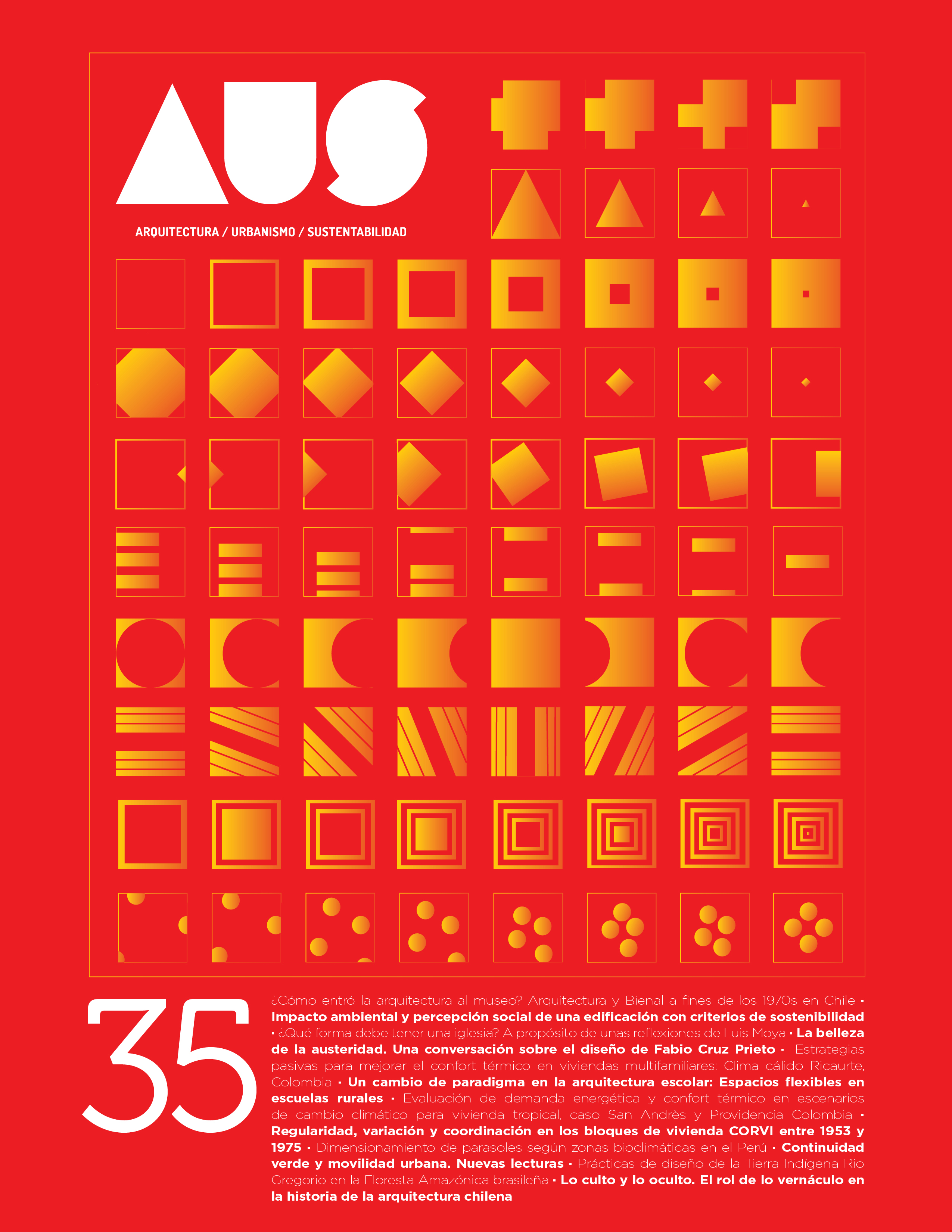A Paradigm Shift in School Architecture: Flexible Spaces in Rural Schools
Main Article Content
Abstract
The integration of flexibility in educational spaces arises from the need to adapt the physical learning environment to the requirements of the pedagogical transformation of the 21st century. The goal is to develop a methodology to evaluate flexibility in educational spaces. In this case, eight rural schools are assessed in the Araucanía region of Chile; their designs address changes in educational paradigms, since their educational spaces were conceived for different learning modalities. An analysis methodology was developed that evaluates the architectural intentions that contribute to flexibility of use and spatial flexibility. The results suggest that the integration of design criteria has been efficient in the areas of spatial proportion, multifunctionality of use and convertibility of the spaces. However, the introduction of furniture and flexible elements to promote space adaptation was identified as a need. Finally, the importance of further investigating design aspects and use of educational spaces that support emerging didactic approaches is discussed.
Article Details
References
Abos, P., y Boix, R. (2017). Evaluación de los aprendizajes en escuelas rurales multigrado. Aula Abierta, 45, 41-48. https://doi.org/10.17811/rifie.45.2017.41-48.
Anbari, M., y Soltanzadeh, H. (2015). Child-oriented architecture from the perspective of environmental psychology. European Online Journal of Natural and Social Sciences, 3(3 Special Issue on New Trends in Architecture, Civil Engineering, and Urban Studies), 137–144.
Attai, S. L., Reyes, J. C., Davis, J. L., York, J., Ranney, K., y Hyde, T. W. (2021). Investigating the impact of flexible furniture in the elementary classroom. Learning Environments Research, 24(2), 153–167. https://doi.org/10.1007/s10984-020-09322-1.
Barrett, P., Zhang, Y., y Barrett, L. (2011). A child’s eye view of primary school built environments. Intelligent Buildings International, 3(2), 107–123. https://doi.org/10.1080/17508975.2011.582315.
Barrett, P., Zhang, Y., Davies, F., y Barrett, L. (2015). Clever Classrooms: Summary report of the HEAD Project (Issue February).
Barrett, P., Barrett, L., y Zhang, Y. (2016). Teachers’ views of their primary school classrooms. Intelligent Buildings International, 8(3), 176–191. https://doi.org/10.1080/17508975.2015.1087835.
Barrett, P., Treves, A., Shmis, T., Ambasz, D., y Ustinova, M. (2019). The Impact of School Infrastructure on Learning: A Synthesis of the Evidence. The World Bank. https://doi.org/10.1596/978-1-4648-1378-8.
Bautista, G., y Borges, F. (2013). Smart Classrooms: Innovation in formal learning spaces to transform learning experiences. Bulletin of the IEEE Technical Committee on Learning Technology, 15(3), 18–21.
Bluyssen, P. M., Kim, D. H., Eijkelenboom, A., y Ortiz-Sanchez, M. (2020). Workshop with 335 primary school children in The Netherlands: What is needed to improve the IEQ in their classrooms? Building and Environment, 168(August 2019), 106486. https://doi.org/10.1016/j.buildenv.2019.106486.
Bos, M., Schwartz, L. y Licheri, M. (2018). Escuelas del siglo XXI en América Latina y el Caribe. División de Educación, Banco Interamericano de Desarrollo (BID).
Chiles, P. (2015). Building Schools: Key Issues for Contemporary Design (Birkhäuser).
de la Vega Rodríguez, L.F. (2020). Investigación sobre enseñanza y desarrollo profesional docentes en escuelas rurales: una revisión. REXE 20(43), 307-325. http://dx.doi.org/10.21703/rexe.20212043delavega16.
Dovey, K., y Fisher, K. (2014). Designing for adaptation: The school as socio-spatial assemblage. Journal of Architecture, 19(1), 43–63. https://doi.org/10.1080/13602365.2014.882376.
Hernando Calvo, A. (2015). Viaje a la escuela del siglo XXI (Fundación).
Istance, D., y Kools, M. (2013). OECD work on technology and education: Innovative learning environments as an integrating framework. European Journal of Education, 48(1), 43–57.
Kariippanon, K. E., Cliff, D. P., Okely, A. D., y Parrish, A. M. (2020). The ‘why’ and ‘how’ of flexible learning spaces: A complex adaptive systems analysis. Journal of Educational Change, 21(4), 569–593. https://doi.org/10.1007/s10833-019-09364-0.
Lippman, P. C., Architecture, J., y York, N. (2010). Can the Physical Environment Have an Impact on the Learning Environment? https://doi.org/10.1787/5km4g21wpwr1-en.
Matthews, E., y Lippman, P. C. (2020). The Design and Evaluation of the Physical Environment of Young Children’s Learning Settings. Early Childhood Education Journal, 48(2), 171–180. https://doi.org/10.1007/s10643-019-00993-x.
Maxwell, L. E. (2007). Competency in child care settings: The role of the physical environment. Environment and Behavior, 39(2), 229–245. https://doi.org/10.1177/0013916506289976.
Ministerio de Educación. (2014). Fundamentos: otros indicadores de calidad educativa. Ministerio de Educación de Chile. https://bibliotecadigital.mineduc.cl/bitstream/handle/20.500.12365/10447/OIC.pdf?sequence=1&isAllowed=y.
Ministerio de Educación. (2016). Criterios de diseño para los nuevos espacios educativos. Ministerio de Educación. División de Planificación y Presupuesto. Departamento de Infraestructura Escolar. https://bibliotecadigital.mineduc.cl/bitstream/handle/20.500.12365/4638/criterios_dise%c3%b1o_espacios_educativos.pdf?sequence=1&isAllowed=y.
Ministerio de Educación de Chile. (2018). Criterios de diseño para los nuevos espacios educativos. 108. http://ingenieriaacustica.cl/blog/wp-content/uploads/2016/01/criterios_de_diseño_para_espacios_educativos_fep.pdf
Ministerio de Educación, Nueva Zelandia. (2020). Designing Quality Learning Spaces-Indoor Air Quality y Thermal Comfort Designing Quality Learning Spaces (DQLS).
Minhas, P., y Nair, P. (2022). The Design of Learning Environments. White Paper for the Association for Learning Environment. https://educationdesign.com/wp-content/uploads/2022/03/The-Design-of-Salutogenic-Learning-Environments-A4LE-Final.pdf
Monahan, T. (2002). Flexible Space and Built Pedagogy: Emerging IT Embodiments. Inventio, 4(1), 1–19. http://publicsurveillance.com/papers/Inventio.html
Mosharraf, H. M., y Tabaeian, S. M. (2014). The Importance of Environmental Psychology in Design of Educational Spaces. 8(March), 996–1000.
Mulcahy, D., Cleveland, B., y Aberton, H. (2015). Learning spaces and pedagogic change: envisioned, enacted, and experienced. Pedagogy, Culture and Society, 23(4), 575–595. https://doi.org/10.1080/14681366.2015.1055128.
Nair, P. y Fielding R. y Lackney J. (2009). The language of school design: Design patterns for 21st century schools. DesignShare.
Nair, P. (2019). Blueprint for Tomorrow: Redesigning Schools for Student-Centered Learning. Harvard Education Press.
Oblinger, D. (2006). Learning spaces. EDUCAUSE.
Organización para la Cooperación y el Desarrollo Económicos (OCDE), Programa LEEP. (2017). Framework for a Physical Learning Environment Module. 1–56.
Red de Educación. (2012). Aprendizaje en las escuelas del siglo XXI. Banco Interamericano de Desarrollo (BID).
Rodríguez Méndez, F. J. (2021). Papel de la “calle de aprendizaje” en la arquitectura escolar española del siglo XX. Paedagogica Historica, 57(1–2), 104–125. https://doi.org/10.1080/00309230.2021.1897147.
Touceda, M., Berbel, M., Denef, J., Dawance, S., y Ribeiro, A. (2018). Mon école, un espace de qualité. Guide pour l’enseignement fondamental. Perspective.brussels. https://perspective.brussels/sites/default/files/documents/mon_ecole_un_espace_qualite_0.pdf
Woodman, K. (2016). Re-Placing Flexibility: Flexibility in Learning Spaces and Learning. Fisher, K (Ed.). The Translational Design of Schools: An Evidence-Based Approach to Aligning Pedagogy and Learning Environments, The Translational Design of Schools: An Evidence-Based Approach to Aligning Pedagogy and Learning Environments, (1), pp.51-79. Sense Publishers.
Zhang, D., Ortiz, M. A., y Bluyssen, P. M. (2019). Clustering of Dutch school children based on their preferences and needs of the IEQ in classrooms. Building and Environment, 147(October 2018), 258–266. https://doi.org/10.1016/j.buildenv.2018.10.014.

